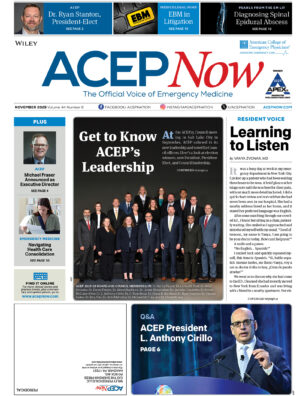Telemedicine refers to the use of technology to create a virtual connection between clinicians and patients to facilitate health care delivery. The goal is to facilitate and optimize communication and consultation. Some acute care telemedicine was already in use prior to COVID-19 in places like urgent care, emergency departments, and hospital floors. Telemedicine use has undergone a meteoric rise since March.
Explore This Issue
ACEP Now: Vol 39 – No 07 – July 2020As telemedicine has become mainstream, a brewing lingo problem has begun to bubble. In short, we need to agree on a shared terminology. For example, the terms “direct-to-consumer,” “retail,” “tele-stroke,” “e-ICU,” “tele-ICU,” “e-emergency,” “ET3,” and many others are frequently bandied about without clear definitions. This variation in nomenclature is a veritable word salad. This can create confusion and miscommunication, even among insiders. We need to align the terminology to provide a consistent description of these concepts to enhance communication efficiency and program effectiveness.
Acute, Emergency, Hospital Care Nomenclature
Here we propose a standardized telemedicine nomenclature for acute, emergency, and hospital care. An effective nomenclature taxonomy should be 1) sufficiently descriptive, 2) create mutually exclusive categories wherever possible, 3) avoid overly burdensome language, 4) be intelligible to multiple audiences, and 5) be expandable to describe future use cases and concepts. Our nomenclature, which we call the Pines-Aldeen Acute Care Telemedicine (PAACT) Classification, involves two distinct positions for words/phrases (similar to Arabic numeral digits) for each use case. The first word/phrase describes the source of the patients. The second word/phrase describes the use case with the “Tele-” prefix added.
As an example, Healthsystem Tele-Observation is the use of telemedicine to deliver observation services within a hospital or health system. By contrast, Employer Tele-UrgentCare is the more traditional, direct-to-consumer telemedicine (eg, Teladoc or American Well) delivered to employer clients for acute urgent (mostly low-acuity) care.
| Use Case | Patient Source | Program Goal | Consult Type | |
|---|---|---|---|---|
| Patient-Clinician | Clinician-Clinician | |||
| Employer Tele-UrgentCare |
Employees with acute, unscheduled, low-acuity complaints | Provide medical care for low-acuity, unscheduled complaints; triage higher acuity care to appropriate setting/specialist | X | |
| EMS Tele-UrgentCare |
Pre-hospital workers who have identified ambulance patients eligible for treat & release telehealth | Provide medical care for low-acuity, unscheduled complaints; triage higher acuity care to appropriate setting/specialist | X | X |
| Healthsystem Tele-Consult (Tele-Stroke, Tele-Psychiatry, Tele-[Specialty]) |
Healthsystem/hospital patients with specific conditions requiring unscheduled specialist care not available in person | Deliver timely specialist care in acute-care settings | X | X |
| Healthsystem Tele-Emergency |
Healthsystem/hospital patients with acute, unscheduled, higher-acuity complaints who may need ED care | Provide medical care for more serious unscheduled complaints; triage higher acuity care to appropriate setting/specialist | X | |
| Healthsystem Tele-UrgentCare |
Healthsystem/hospital patients with low-acuity, acute, unscheduled complaints | Provide medical care for low-acuity, unscheduled complaints; triage higher acuity care to appropriate setting/specialist | X | |
| Healthsystem Tele-FollowUp |
Healthsystem/hospital patients who have been recently discharged from the ED or hospital | Identify and remediate problems and concerns post-discharge | X | |
| Healthsystem Tele-Hospitalist |
Healthsystem/hospital patients admitted to the hospital floor | Provide remote staffing to improve efficiency | X | X |
| Healthsystem Tele-ICU |
Healthsystem/hospital patients admitted to the hospital ICU | Provide remote staffing to improve efficiency | X | X |
| Healthsystem Tele-Observation |
Healthsystem/hospital patients in the observation unit | Provide remote staffing to improve efficiency | X | X |
| Healthsystem Tele-Triage |
Patients who have presented to the ED | Reduce time-to-clinician and shorten ED length-of-stay and reduce left-without-treatment by placing orders early | X | |
| Insurer Tele-UrgentCare |
Insurer beneficiaries with acute, unscheduled complaints, or those who have been referred from an insurer nurse triage line | Provide medical care for low-acuity, unscheduled complaints; triage higher acuity care to appropriate setting/specialist | X | X |
| School Tele-UrgentCare |
School students where school nurses have questions about acute, unscheduled complaints | Provide medical care for low-acuity, unscheduled complaints; triage higher acuity care to appropriate setting/specialist | X | X |
| SNF Tele-Emergency |
Skilled nursing facility (SNF) residents identified by SNF staff with acute, unscheduled complaints who are eligible for treat & release telehealth | Provide medical care for low-acuity, unscheduled complaints; triage higher acuity care to appropriate setting/specialist | X | X |
We propose the explicit category of Tele-Emergency for patients (and for other stakeholders within health systems) who think they may need an emergency department. Tele-Emergency would skew toward the higher-acuity cases (eg, abdominal pain) while Tele-UrgentCare is conceptualized for lower-acuity care (eg, seasonal allergies). Table 1 describes each use case with a description of the source of the patients and the specific telemedicine services delivered. The table is not designed to be comprehensive; with its position-based digit system, the PAACT Classification allows any stakeholder to build upon the nomenclature with simple terms understandable by all. For example, a third word/phrase position could be added to describe the exact technology used or another variable.
With the PAACT Classification, we anticipate more efficient communication to describe and advance the science of telemedicine to achieve improvements in patient outcomes, experience of care, and cost savings.
Dr. Pines is the national director of clinical innovation at US Acute Care Solutions and professor of emergency medicine at Drexel University in Philadelphia.
Dr. Aldeen is chief medical officer of USACS and is based in Tampa, Florida.
Pages: 1 2 | Multi-Page



No Responses to “It’s Time to Standardize the Nomenclature of Acute Care Telemedicine”